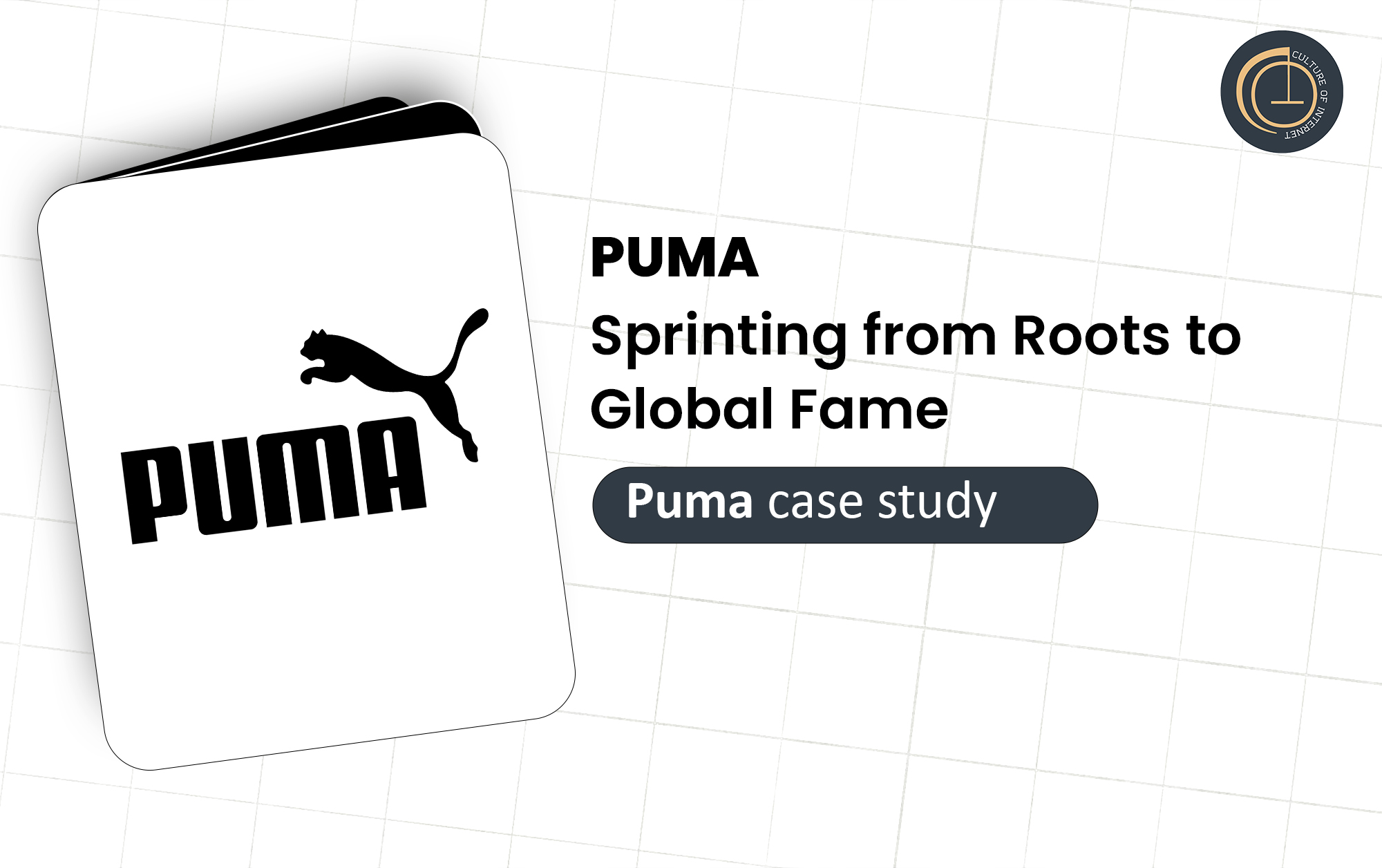Origin
Born from a Brotherly Split PUMA was founded in 1948 in Herzogenaurach, Germany, by Rudolf Dassler, after a dramatic fallout with his brother Adi Dassler, who went on to create Adidas. Before this split, both brothers worked together under the name "Gebrüder Dassler Schuhfabrik" (Dassler Brothers Shoe Factory), founded in the 1920s.
Their company gained fame when athlete Jesse Owens wore their shoes during the 1936 Berlin Olympics and won four gold medals. However, personal tensions and differing visions caused a split in 1948, and the brothers went their separate ways—Rudolf founded PUMA Schuhfabrik Rudolf Dassler, and Adi created Adidas.
This rivalry not only birthed two global giants but also set the tone for decades of competitive innovation in sportswear.
Position
-
Among the Titans Today, PUMA is the third-largest sportswear manufacturer in the world, after Nike and Adidas. Despite intense competition, it has managed to carve a unique position by combining performance and style. It’s especially known for its innovative approach in combining sports functionality with urban fashion appeal.
-
PUMA's presence spans over 120 countries, with more than 14,000 employees worldwide. It dominates markets in Europe, North America, Asia, and Africa, and maintains a strong brand recall among youth and athletes alike.
USP (Unique Selling Proposition)
Style Meets Performance PUMA’s strength lies in its ability to seamlessly blend sport and lifestyle. Its USP revolves around:
-
SportStyle Fusion: Athletic wear with edgy, stylish design—making it wearable on and off the field.
-
Celebrity Collaborations: Strategic partnerships with icons like Rihanna, Usain Bolt, Selena Gomez, and Neymar Jr. have given PUMA a major edge in connecting with younger audiences.
-
Innovation-Driven: Products like PUMA Ignite, RS-X, and Nitro running shoes focus heavily on performance technologies.
-
Inclusive Branding: Unlike other brands, PUMA has positioned itself as accessible, inclusive, and trend-savvy.
-
This blend of functionality and fashion is what makes PUMA’s appeal universal.
Existence
-
A Legacy That Evolved with Time PUMA's existence over the decades is a textbook example of how a brand can adapt to the changing needs of the consumer without losing its essence.
-
In the 1950s, PUMA introduced the first football boot with screw-in studs, a revolutionary design that changed football forever.
-
The 1968 Olympics brought PUMA global recognition when Tommie Smith, wearing PUMAs, raised his fist in the iconic Black Power salute.
-
Through the 70s to 90s, the brand built deep roots in football, motorsport, basketball, and athletics.
-
In the 2000s, a major reinvention took place under CEO Jochen Zeitz, who turned financial losses into profitability by making PUMA a "sportlifestyle" brand.
-
From traditional sports gear to urban fashion essentials, PUMA has continually evolved while maintaining its core DNA.
Power of Network
Global Supply and Star Endorsements PUMA's network is vast, strategic, and meticulously organized:
-
Global Retail Footprint: Over 830 own retail stores, plus partnerships with online retailers and physical stores worldwide.
-
Sponsorship Powerhouse: PUMA sponsors several national football teams (like Italy, Uruguay, and Ghana), individual clubs (like Manchester City, AC Milan), and athletes (including Usain Bolt, the world’s fastest man).
-
Strategic Regional Hubs: Operational hubs in Germany (HQ), Boston, Hong Kong, and Ho Chi Minh City allow regional responsiveness and global coherence.
Sponsorship Powerhouse
-
PUMA sponsors several national football teams (like Italy, Uruguay, and Ghana), individual clubs (like Manchester City, AC Milan), and athletes (including Usain Bolt, the world’s fastest man).
-
Strategic Regional Hubs: Operational hubs in Germany (HQ), Boston, Hong Kong, and Ho Chi Minh City allow regional responsiveness and global coherence.
Online Expansion
-
PUMA's e-commerce and digital strategy have rapidly scaled, especially post-pandemic, with heavy focus on direct-to-consumer sales.
-
This network ensures brand visibility, real-time consumer feedback, and operational efficiency.
Diversification
-
Product Range Diversification :
-
Footwear (performance and lifestyle)
-
Apparel (jerseys, gym wear, casual fashion)
-
Accessories (bags, socks, headwear, fitness tools)
-
Motorsport and Golf Gear
-
Smartwear and sustainable lines
-
-
Market Segmentation :
-
Performance-Focused Sports : Football, running, training, motorsport
-
Lifestyle Fashion : Streetwear, youth fashion
-
Female-Centric Collections : Launched fashion-forward women's lines under Rihanna and Dua Lipa
-
PUMA’s multi-category presence ensures it’s never overly dependent on one market or demographic.
-
-
Collaboration & Partnerships
-
The Brand’s Secret Weapon PUMA has mastered the art of collaboration. Unlike traditional brand endorsements, PUMA co-creates products with celebrities, designers, and even cultural icons. Some standout partnerships include.
-
Rihanna (FENTY x PUMA) : This partnership redefined streetwear for women and broke sales records.
-
KARL LAGERFELD, ADER ERROR, and SOPHIA WEBSTER : High-fashion collabs that made PUMA a fashion-forward choice.
-
Neymar Jr. and Antoine Griezmann : Reinforcing PUMA’s stronghold in football.
-
Mercedes AMG Petronas F1, BMW Motorsport : Tapping into high-performance motorsports.
-
These partnerships don't just generate buzz—they introduce new aesthetics, fan bases, and global exposure.
-
From Cleats to Catwalks What makes PUMA incredibly resilient is its diversification—not just in product categories, but also across markets, styles, and customer types:
Strategies Followed
Fast, Agile, Consumer-Centric PUMA’s strategy has revolved around being “Forever Faster”, and it reflects in its business moves:
Consumer First
Focus on understanding local markets and tailoring campaigns
Data-driven marketing and e-commerce strategies
Digital Transformation
Strong investments in social media, influencer marketing, mobile apps, and e-commerce optimization
Sustainability
10FOR25 Strategy: Covers fair wages, renewable energy, waste management, and biodiversity
Sustainable materials like recycled polyester and biodegradable cotton
Speed to Market
Adopting demand-driven supply chains, faster prototyping, and real-time inventory trackinges.
Revival of Women's Segment
Focused expansion in women’s wear, powered by collaborations and fresh designs
PUMA’s agility and willingness to experiment keep it one step ahead in a competitive landscape.
Problems Faced
-
Sibling Rivalry Legacy : Constant comparison with Adidas, its larger and more profitable cousin, created pressure to outperform
-
Market Share Battles : Nike and Adidas dominate key global markets—making it hard for PUMA to lead despite strong visibility
-
Brand Perception Drift : During the late 90s and early 2000s, PUMA lost ground as it struggled to balance sports with fashion, leading to an identity crisis
-
Supply Chain Challenges : COVID-19 pandemic exposed vulnerabilities in global supply chains and slowed down production and delivery
-
Counterfeit Products : Like all major fashion brands, PUMA has battled counterfeit goods, especially in emerging markets
Every Race Has Hurdles Like any major brand, PUMA has faced its share of challenges:
Stats
-
Revenue : €8.6 billion globally
-
Employees : Over 14,000 worldwide
-
Operating Income : ~€641 million
-
Footwear Revenue Share : Around 50% of total revenue
-
Top Markets : Europe (30%), Americas (38%), Asia/Pacific (27%)
-
Social Media Presence : Over 25 million followers across platforms
-
Retail Presence : 830+ stores globally, plus major online retail partners
Numbers That Speak Volumes Here are some standout numbers and data points that showcase PUMA’s strength and scale (as of 2024):
The numbers clearly show that PUMA is not just surviving—it’s thriving.
Final Lap
PUMA’s Enduring Legacy PUMA has always stood for more than just sportswear. It’s a brand that celebrates speed, boldness, and self-expression. Whether it's an athlete chasing Olympic dreams, a teenager rocking high-top RS-Xs, or a fashionista flaunting the latest FENTY collab—PUMA is there, shaping how people express performance and personality.
Its commitment to innovation, sustainability, and cultural relevance ensures that it's not just running the race—it’s defining it.
As PUMA continues to evolve, it reminds the world that success isn’t always about being the biggest. Sometimes, it’s about being the fastest to change, the smartest to collaborate, and the boldest to believe.
Explore Our Comprehensive Marketing Strategy Course
Join our in-depth course to master Puma India's marketing strategies, learn from expert case studies, and gain actionable insights to apply in your own business or career.









